The History Of Vauxhall Vectra

The Opel Vectra is a large family car produced primarily by Opel, the German subsidiary of General Motors Europe (GM Europe is a subsidiary of the multinational General Motors). In the United Kingdom, it is sold under the Vauxhall marque as Vauxhall Vectra (except the Vectra A, which was known as the Vauxhall Cavalier). It has been also been sold by Holden in Australasia as Holden Vectra, and Chevrolet in Latin America as Chevrolet Vectra.
The Vectra was introduced in 1988 as a replacement to the Opel Ascona and itself was replaced in 2008 by the Opel Insignia, that will retain the Chevrolet Vectra name for the Latin American market.
The first Vectra, known as the Vectra A, was introduced in 1988 as a saloon and hatchback, replacing the Opel Ascona C. A coupé based on the Vectra, called the Calibra, was also sold. Both cars were designed by then-Opel design chief Wayne Cherry. Vauxhall, GM's British subsidiary which shared most of its models with Opel, did not call this model "Vectra" but rather marketed it as the Cavalier.
Engines ranged initially from a 75PS (55kW) 1.4L to a 130PS (96kW) 2.0L Family II. With the introduction of Euro I emissions regulations, the base model was replaced by a 1.6L with the same output, while the top of the line was given to a 16-valve version of the 2.0L engine, which powered the GT (GSI) version, and had 150PS (110kW). Four-wheel drive versions were added to the lineup in 1990, and in 1993, the car received a limited edition turbocharged version, with 204PS (150kW). The 1.4-litre engine was not available in all markets, and even then, it was only available in basic trims (Base/ L in United Kingdom, LS/ GL in Europe). A 2.5L V6 engine appeared towards the later stages of the Vectra's life, developing 170 PS (125kW), turning the car into a relaxed motorway cruiser rather than give it sporty pretensions.
There were a choice of two diesel engines; one was an Isuzu 1.7L Circle-L unit, in both naturally-aspirated and turbocharged form (1686cc), this one capable of achieving 82PS (60kW), and a GM designed 1.7 "low blow" turbo-diesel (1699cc), and naturally-aspirated diesel unit, delivering up to 68PS (67hp/ 50kW). Both units have a reputation for longevity, especially Isuzu developed units, which were also regarded as some of the most refined diesels available at the time.[citation needed]
The front suspension was fully independent, with MacPherson struts, pressed steel lower control arms, and an anti-roll bar. The front suspension, together with the major mechanicals (engine and transmission) is remotely mounted on a front subframe. On front wheel drive models, the rear suspension is semi-independent, consisting of a torsion beam axle linked to trailing arms, with double conical coil springs and direct acting telescopic hydraulic shock absorbers, with certain models also having an anti-roll bar. On the four wheel drive GSi, the rear suspension is a subframe-mounted fully independent design, with semi-trailing arms, double conical coil springs, direct acting gas-assisted telescopic shock absorbers, and an anti-roll bar.
Steering gear is a rack and pinion type (manual or power assisted, depending on model), mounted on the bulkhead (firewall), with a telescopically deformable steering column.
The Vectra also received a refresh in 1993.
The Vectra gave birth to a coupé version, the Opel Calibra, which shared the Vectra's underpinnings, including the most powerful engines (115PS and up) and transmissions.
In New Zealand, the Vectra A was offered initially as an Opel, but it wore Holden badges from 1994. It was not sold in Australia, where Holden instead offered a rebadged Toyota Camry called Apollo until 1997.
In Brazil, the Chevrolet-badged Vectra A was not introduced until 1993, when it replaced the Chevrolet Monza, a restyled version of the last Ascona.
In Egypt, the Opel Vectra A was not introduced until 1994 through GM Egypt Dealerships, and started production in late 1994 by GM Egypt through early 1996 with a range of 1.6 GL ,2.0 GL trim and 2.0 GLS trim and only Saloon body style boosting strong sales in Egypt during this short run in Egypt.
Common Engine Lineup for Vectra A
The second model, the Vectra B, was introduced in 1995, and the model range included an estate version for the first time. This model replaced the Vauxhall Cavalier in the UK, and the Holden Apollo in Australia. In 1998, Holden began assembly of the Vectra for export to other right-hand drive markets in the region, although this was aversely affected by the Asian economic crisis, and ended in 2001.
Engines started from the 71PS (52kW) 1.6L, Family 1 but eventually the 8-valve engines were all replaced by 16-valve powerplants. The 2.0L Family II engine, with 136PS (100kW) was developed as a basis for touring car racing (later in Australia, 2.2 L 108kW), but the top of the line was a 2.5L V6 with 170PS (125kW). Diesel power came once again from Isuzu, but now featured direct injection and a 16-valve head.
In 1999 the Vectra was updated, receiving a mildly modified body (that can be identified by the single piece headlight units and body-coloured bumpers) together with somewhat improved handling characteristics and better equipment.
Sporting limited edition models included the touring car championship inspired i500, Super Touring and GSi. The first model was developed in Germany by Opel Motorsport, with the V6 engine's power increased to 195PS (143kW), and the other two were created in Milton Keynes by Motor Sport Developments, the team that run the Vectras in the British Touring Car Championship (BTCC). Only 3900 GSi models were ever produced, mostly in saloon and hatchback guise. With only 317 estate versions produced during this time, they became one of the rarest production Vauxhalls ever.
A related model sold in the United States was the Saturn L-Series, introduced in 2000 but dropped from the lineup in 2005. It was replaced by the 2007 Saturn Aura, which was built around GM's Epsilon architecture, as the Vectra C is.
In Egypt, the production of the Opel Vectra B continued in mid-1996 with two models, initially a 1.6l 8v GLS trim with manual transmission and a 2.0l 8v CD trim with automatic transmission. Later in 2000 the revised model was produced with three models 1.6 16v GLS trim with automatic transmission, 2.0 16v CD trim with automatic transmission, and a 2.0 CDX trim automatic transmission and all with saloon body style. In 2002 local production of the Opel Vectra ceased in favour of the Opel Corsa Sedan and Opel Astra Sedan.
Built over the GM Epsilon platform the Opel Vectra C of 2002 was initially available as a four-door sedan and a five-door hatchback, known as the GTS. A five-door station wagon was added in 2003, along with an "executive hatchback" sold under the Signum nameplate. The Signum, which is based partly on the Vectra C features a completely different layout in the rear.
The engine range was substantially modified to account for an increased curb weight. While a 90kW (121hp) 1.8litre Family 1 Ecotec engine was reserved for the base model, a 2.0litre turbocharged Family II engine with 129kW (173hp) was also offered, along with a new 3.2litre V6, with 155kW (208hp). Diesel power, which by now was important for commercial success in Europe, is provided by an Isuzu-sourced 3.0litre V6 outputting 132kW (177hp), but the four-cylinder diesel engine was replaced in 2004 by a Fiat-designed 1.9litre Ecotec CDTI engine capable of outputting 110kW (148hp). Handling is reported to be much better than the old car, but reviews still criticise the overlight feel of the steering, complicated indicator switches and the rather ungainly styling of the sedan version.[citation needed]
The Vectra received a facelift near the end of 2005, and the V6 engine was replaced by an Australian-built turbocharged 2.8litre High Feature V6 unit. More importantly, Opel introduced, for the first time, an OPC version the Vectra was launched, using the VXR name in the United Kingdom. These high-performance variants were available only in the hatchback and station wagon bodies. In the United Kingdom, the power on the High Feature engine was increased to 188kW (252hp), and maximum speed just falls short of 250km/ h (155mph). In Australia and New Zealand, the Holden Vectra ZC series was dropped and replaced with the Holden Epica, a badge-engineered Daewoo Tosca in 2007. Due to stockpiling of 2005 model Vectras for the Australasian market, there was enough supply of the car for deliveries to last through to 2007, as a result facelifted Vectra Cs were not sold in those markets.
Sales of the Vectra in the United Kingdom have not been as strong as its predecessor's. For much of its production life, the original Vectra was the fourth best selling car in the country, yet the Vectra C has never come higher than tenth in the country's car sales charts, though it is still the second best selling car in its sector behind the Ford Mondeo. In 2007, it finally made the top 10 of Britain's car sales charts, being the nation's tenth most popular new car with over 50,000 sales, outselling the Ford Mondeo for the first time since 1999. Also in 2007, the station wagon variant garnered the Estate Car of the Year 2007 award by What Car? magazine.
While the Vectra C has been sold in Mexico and Chile as the Chevrolet Vectra, it is not marketed in Brazil, where Chevrolet opted to sell the Astra C under the Vectra brand since October 2005, keeping the Astra B as the cheaper option. Both localized versions still uses the obsolete powertrain from the Chevrolet Monza.
From Wikipedia, the free encyclopedia
More About Vauxhall Vectra
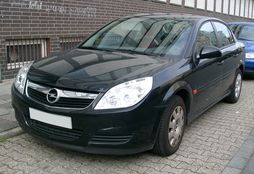
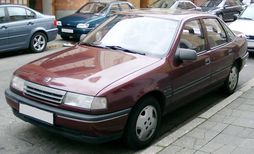
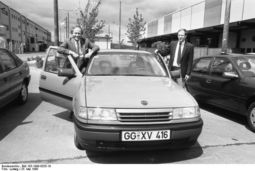
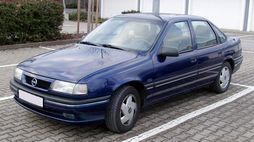
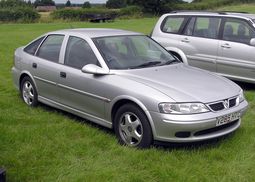
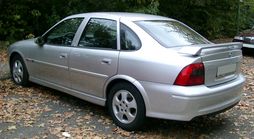
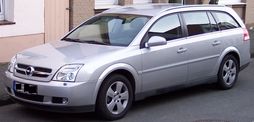
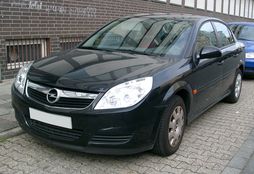
|